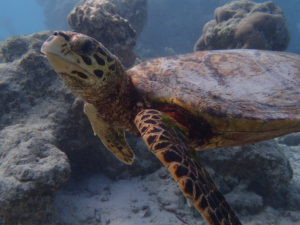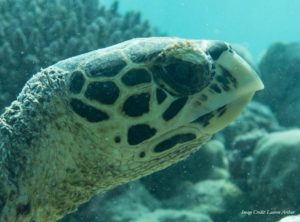 An important aspect of our research is Photographic Identification, or photo-ID. This is the process of recognizing individual animals of a species from unique markings on their body.
An important aspect of our research is Photographic Identification, or photo-ID. This is the process of recognizing individual animals of a species from unique markings on their body.

Photo-ID is a scientifically proven method of “tagging” animals . Individual turtles can be ID’d by comparing their facial scales, which are unique. This method was developed by Jean et al. (2010).
Photo-ID is a cost-effective, non-invasive technique that can easily be used to monitor sea turtles without disturbing them. It is a great way to involve “citizen scientists”, that is, members of the general public with little to no scientific training.
The Maldives is particularly suited for a citizen science data collection program, given the number of tourists that visit the country specifically to dive, snorkel, and view marine wildlife. Photo-ID can be used as a “capture-mark-recapture” method. Statistical modelling of a series of photos can reveal patterns of residency and movement between reefs, determine the population and population structure of a reef at a given time, calculate inter-nesting periods, etc.
The results can be combined with the Maldivian government’s TurtleWatch database to develop and evaluate turtle conservation measures. ORP is also working with other groups around the world to develop “The Internet of Turtles”, which will be a data-sharing platform for PhotoID research. As of August 2020, there were over 25,450 sightings logged in the Photo-ID database of 3,184 individual Hawksbill turtles and 840 individual Green turtles.

Dr. Jillian Hudgins, our Project Scientist, will be co-leading a workshop on Photo-ID at the International Sea Turtle Symposium (ISTS) in Las Vegas next year. We are excited to develop this technology and stay at the forefront of new methods to research and protect sea turtles.
References:
Visit ISTS here: http://internationalseaturtlesociety.org/
Jean, C., Ciccione, S., Talma, E., Ballorain, K., & Bourjea, J. (2010). Photo-identification method for green and hawksbill turtles-First results from Reunion. Indian ocean turtle NewsLeTTER, 11, 8-13. http://www.iotn.org/wp-content/uploads/2015/09/IOTN11.pdf#page=10

